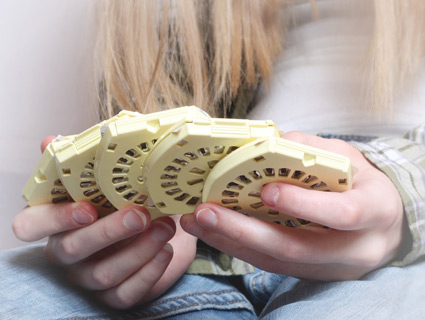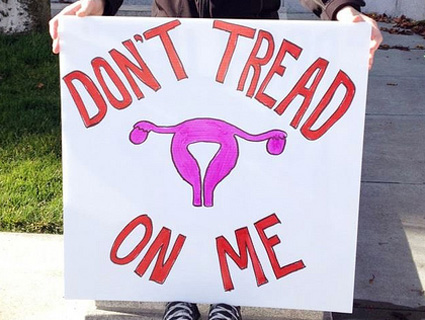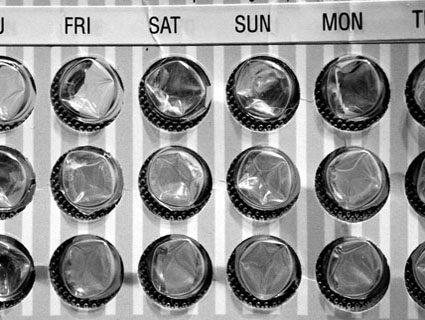Data from 2006 except for the US, which is from 2009. Source: Guttmacher Institute
It’s easy to forget, amidst the current threats to restrict access to contraception, that for much of their lives, women still face the dilemma of which type of birth control to use. My friends and I are no different: More and more of us are now choosing intrauterine devices, those hormone-emitting or copper-wrapped plastic wonders that I hadn’t paid much attention to until about a year or two ago, when I decided to switch to an IUD. After one albeit painful appointment to get the tiny instrument inserted, I no longer have to remember to take a pill or worry about needing to re-up my supply every month or before traveling; lucky for me, my insurance paid for the whole shebang. (My colleagues Kate Sheppard and Stephanie Mencimer both wrote about recently landing on this option, too.)
As it turns out, we’re in the minority. Although long-lasting reversible contraceptive methods (LARCs) like IUDs are pretty popular in Europe (27 percent of Norwegian female contraception users have one) and China (41 percent!), only around 8.5 percent of women in the United States choose these as their birth control method, among the lowest of any developed country, according to a recent report by the Guttmacher Institute. But while at least half of my girlfriends now have IUDs, some of them have had to jump through hoops and even lie to convince their doctors to prescribe them one. Why has it been hard for young women in the United States to get their hands on this type of birth control?
The American stigma against IUDs almost certainly traces back to a scare in the ’70s and ’80s surrounding the Dalkon Shield IUD, a poorly designed device that wicked bacteria up its string and sometimes resulted in infections, septic miscarriages, and even death. (Mother Jones reported on it back in a 1979 issue.) In the years after the controversy, reported Adam Sonfield of the Guttmacher Institute, “the media trumpeted a series of studies linking the Shield and other IUDs to pelvic inflammatory disease and subsequent infertility.” IUDs since have been reengineered and deemed safer, but physician and consumer mistrust has lingered.
In the meantime, women in other parts of the world—where the Dalkon Shield scare had less impact—have chosen IUDs in large numbers. The graph above reveals how popular its usage is in parts of Europe.
Additionally, in his recent report on changes in contraceptive use, Guttmacher’s Dr. Lawrence Finer also noted that 41 percent of Chinese women use either the IUD or an implant, another type of LARC. The United Nations, which tracks global contraceptive usage for women who are married or cohabiting, discovered in 2011 that women in less-developed countries were nearly twice as likely to use IUDs than women in Europe and North America. Dr. Kabir Ahmed of the United Nations Population Fund has a theory about this: “Oral contraceptives aren’t as popular among lower-literate populations because these women don’t want their husband to know they are taking anything.” IUDs and implants easily are kept secret. Women in more-developed countries, he explains, don’t need to hide anything and might be more likely to choose the pill because it would allow them to change their minds more quickly.
Although the pill remains the first choice for the majority of American women (see chart below), the IUD is slowly creeping back on the scene.
Source: Guttmacher Institute
Finer reports that the percentage of female contraception users choosing LARC methods in the United States increased from 2.4 percent in 2002 to 8.5 percent in 2009, and the increase “occurred among women in almost every age, race, education, and income group.” The Dalkon Shield paranoia seems to be wearing off, and the two new forms of IUDs—the ParaGard, or copper IUD, and the Mirena, which releases the hormone levonorgestrel—don’t have the same issues the Dalkon did and don’t appear to increase risk for infection 20 days after insertion.
Aside from no longer needing to take a pill every day, women may experience lighter periods and fewer hormonal side effects than the pill on the Mirena IUD; the copper IUD offers a nonhormonal route to blocking sperm. And both types of IUD, as the graph below demonstrates, have far lower failure rates than the pill, condom, spermicide, patch, or diaphragm, especially when you consider typical use (taking into account skipping pills or messing up condom placement, for instance).
Source: Guttmacher Institute
What’s more, the American College of Obstetricians and Gynecologists just this month revised its 2007 guidelines to say that LARCs are appropriate contraceptives for most women and adolescents. (IUDs were traditionally recommended for women who had already gone through at least one pregnancy.) ACOG’s opinion dispels many of the myths surrounding IUDs, arguing that they do not increase risk of infertility, are relatively easy to insert even in women who haven’t given birth, and are safe for use by young women. ACOG recommends that young women should be screened for sexually transmitted infections before having an IUD inserted, but risk of developing infections or pelvic inflammatory disease is pretty low, and only slightly higher for the first 20 days.
ACOG’s groundbreaking opinion also hints at some of the barriers inhibiting IUD use: lack of access and safety concerns (on the part of health care providers) of usage among young women. I don’t remember ever being advised by a health care practitioner to look into an IUD as an option before my current doctor. My friend Cate, a nurse in Denver, had a similar experience. “It’s definitely not something providers push,” she says. “It was never offered to me as an option; it’s something I had to bring in to the conversation.”
To make matters worse, she said, she had noticed a trend of her friends not in “relationships” being denied IUDs by doctors. “They were bullied into not getting one, or weren’t screened as good candidates, but not for medical reasons,” Cate says. When it came time for her to get one, “I went in saying this is what I want, I know the kind I want, and I’m in a relationship,” even though she was single at the time. “I think it made it easier.”
Finer acknowledges that some doctors “are working off of old information and are more hesitant to prescribe newer methods to younger women and women without children.” A 2012 study by the Centers for Disease Control and Prevention showed that a third of practitioners had misconceptions about the safety of IUDs for women who had never given birth. Nurse practitioner Ginny Cassidy-Brinn wrote about this in an article for the National Women’s Health Network:
For many years, practitioners strongly cautioned women against getting an IUD if they wanted to have children later, and often refused to provide IUDs to childless women due to fears about infertility. IUDs were also routinely denied to women who were not in long-term, stable relationships because of concerns they might get an STI that could be exacerbated by an IUD.
Finer says that since women are having children “way later than they used to,” doctors have begun rethinking prescribing IUDs and other LARCs for younger women.
Another issue with the IUD has been its up-front cost. Without insurance, the Mirena costs $843.60, sans the price of insertion. But when researchers at the Department of Obstetrics and Gynecology at University of Washington-St. Louis did an experiment wherein they educated a group of 10,000 women ages 14 to 45 about different contraceptive methods and then offered a method free of charge, 67 percent chose long-acting methods, and 56 percent an IUD. Because the Affordable Care Act will eliminate co-pays for contraceptives, the IUD will soon be in reach for women who previously couldn’t shell out nearly a grand.
Alas, like many health decisions women face, choosing contraception is far from simple. Though I’ve loved my IUD so far, it still has its cons. There’s still a slight risk of an IUD perforating the uterine wall upon insertion, for instance, or that the device will be discharged. Alleged side effects of the Mirena, like undetected perforations, have sparked lawsuits. And unlike the pill, you have to make an appointment to have the IUD removed by a doctor or nurse practitioner.
As another Guttmacher study out this week indicated, women use contraception to better achieve life goals, like caring for ourselves and our families, supporting ourselves financially, and keeping jobs. Picking a contraceptive method that makes us happy ties into more than just our sex lives. Fewer cost barriers, more access to information, and a recent thumbs up from the American College of Obstetrics and Gynecology on IUDs’ safety for young women may mean that more doctors educate their patients—no matter the age—about the IUD option.
















